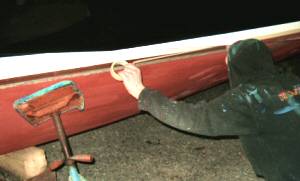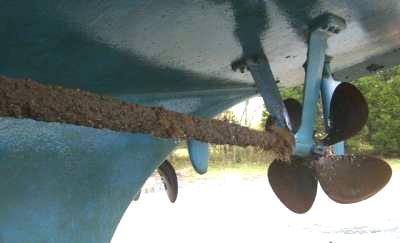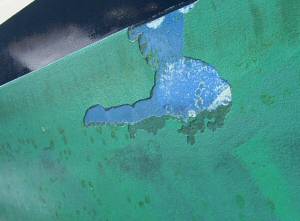
A good bottom job is hardly just slapping a coat of paint on. There is much prep to be done to the bottom and the related gear. We use a check list that we adhere to when we do a bottom to ensure that whomever is doing the job will provide the same level of quality that is given to each job we do.
No job is started before the prep work has begun, in fact applying the bottom paint is the last thing done. When we do a job, we check the bottom first for fiberglass defects, check the integrity of the underwater gear, check for boot top paint problems and hand test speed transducer paddle wheels to ensure they turn as they should. After a through check of the bottom we begin the prep work. You can
download our estimating sheet to see how we figure out costing and what is involved with each part of the job.

Usually the first step we take is to remove the shaft zincs. Now we can start cleaning the props and shafts. Sometimes this is an easy job, sometimes it is not. Any barnacles have usually been removed when the boat is pulled, but not always. And heavily barnacled shafts and props leave a lot of hard residue that can only be removed by sanding. We find that emery cloth is the best solution for this. After a thorough cleaning of the shafts we can install the new zincs. At this time we also do a quick bearing check. If a shaft wiggles in the bearing, the owner is alerted to a potential problem. (see
When Good Bearings Go Bad)
The props also get a good cleaning at this time and if the boat is equipped with a bowthruster, we have to clean the hole, the prop and gear for that and change the zinc on the prop. To do the best job here, it pays to remove the prop and really clean and paint well in this area as any barnacle build up will cause the unit to operate less than functionally.
If a boat is equipped with spurs line cutters, we remove these from the boat and service them as well. These need to be wire brushed and cleaned like new. They will almost always need new zincs and often will need new bearings and silencers to bring them back to factory specs. Then can then be reinstalled after the shafts and props are cleaned.

Next the actual bottom paint preparation can be tackled. In the photo to the left, you can see the effects of too much paint buildup. We would normally recommend that a boat like this have it’s bottom paint blasted off. If the customer prefers not to go that route, areas such as this will need to be sanded back and filled a bit with bottom paint to bring the area up to almost smooth surface. Bear in mind that if the adhesion is bad in one spot, more is likely to follow soon.
So the sanding begins. As part of a full service bottom job, we also remove the strainers and clean and paint inside. This is definitely a spot where you do not want barnacles and other growth as it will limit the water capacity of your intakes. These must be done every year – it is not an option. Also, you must be careful when painting to never paint over these strainers. That is why we paint them with a brush before reinstalling. We also hand paint around this area at this time and around any transducers so when the rolling begins we don’t have to be so careful in these areas.
Next is the taping of the waterline. I have seen some pretty sloppy jobs on boats that have come into the marina. You must have a steady hand, good eye and use the right tape. In fact, we sometimes have someone other than the bottom painter tape this off to make sure it is right. We only use 3M Fineline tape because it leaves a crisp line and does not allow any wicking of paint under the tape (as long as it is applied correctly). From this point on the job is pretty straightforward. We use high quality rollers to ensure the best job. Also very important is to use a paint shaker before applying the paint. We invested in an industrial shaker to ensure that all the solids would be evenly distributed throughout the paint.
As you can see there is more to a bottom job than slopping on a coat of paint. When you invest money in this type of work you need to make sure you are getting the best job available. Some yards will do it cheaper, but will not cover all the bases required to give a quality job.
 A good bottom job is hardly just slapping a coat of paint on. There is much prep to be done to the bottom and the related gear. We use a check list that we adhere to when we do a bottom to ensure that whomever is doing the job will provide the same level of quality that is given to each job we do.
No job is started before the prep work has begun, in fact applying the bottom paint is the last thing done. When we do a job, we check the bottom first for fiberglass defects, check the integrity of the underwater gear, check for boot top paint problems and hand test speed transducer paddle wheels to ensure they turn as they should. After a through check of the bottom we begin the prep work. You can download our estimating sheet to see how we figure out costing and what is involved with each part of the job.
A good bottom job is hardly just slapping a coat of paint on. There is much prep to be done to the bottom and the related gear. We use a check list that we adhere to when we do a bottom to ensure that whomever is doing the job will provide the same level of quality that is given to each job we do.
No job is started before the prep work has begun, in fact applying the bottom paint is the last thing done. When we do a job, we check the bottom first for fiberglass defects, check the integrity of the underwater gear, check for boot top paint problems and hand test speed transducer paddle wheels to ensure they turn as they should. After a through check of the bottom we begin the prep work. You can download our estimating sheet to see how we figure out costing and what is involved with each part of the job.
 Usually the first step we take is to remove the shaft zincs. Now we can start cleaning the props and shafts. Sometimes this is an easy job, sometimes it is not. Any barnacles have usually been removed when the boat is pulled, but not always. And heavily barnacled shafts and props leave a lot of hard residue that can only be removed by sanding. We find that emery cloth is the best solution for this. After a thorough cleaning of the shafts we can install the new zincs. At this time we also do a quick bearing check. If a shaft wiggles in the bearing, the owner is alerted to a potential problem. (see When Good Bearings Go Bad)
The props also get a good cleaning at this time and if the boat is equipped with a bowthruster, we have to clean the hole, the prop and gear for that and change the zinc on the prop. To do the best job here, it pays to remove the prop and really clean and paint well in this area as any barnacle build up will cause the unit to operate less than functionally.
If a boat is equipped with spurs line cutters, we remove these from the boat and service them as well. These need to be wire brushed and cleaned like new. They will almost always need new zincs and often will need new bearings and silencers to bring them back to factory specs. Then can then be reinstalled after the shafts and props are cleaned.
Usually the first step we take is to remove the shaft zincs. Now we can start cleaning the props and shafts. Sometimes this is an easy job, sometimes it is not. Any barnacles have usually been removed when the boat is pulled, but not always. And heavily barnacled shafts and props leave a lot of hard residue that can only be removed by sanding. We find that emery cloth is the best solution for this. After a thorough cleaning of the shafts we can install the new zincs. At this time we also do a quick bearing check. If a shaft wiggles in the bearing, the owner is alerted to a potential problem. (see When Good Bearings Go Bad)
The props also get a good cleaning at this time and if the boat is equipped with a bowthruster, we have to clean the hole, the prop and gear for that and change the zinc on the prop. To do the best job here, it pays to remove the prop and really clean and paint well in this area as any barnacle build up will cause the unit to operate less than functionally.
If a boat is equipped with spurs line cutters, we remove these from the boat and service them as well. These need to be wire brushed and cleaned like new. They will almost always need new zincs and often will need new bearings and silencers to bring them back to factory specs. Then can then be reinstalled after the shafts and props are cleaned.
 Next the actual bottom paint preparation can be tackled. In the photo to the left, you can see the effects of too much paint buildup. We would normally recommend that a boat like this have it’s bottom paint blasted off. If the customer prefers not to go that route, areas such as this will need to be sanded back and filled a bit with bottom paint to bring the area up to almost smooth surface. Bear in mind that if the adhesion is bad in one spot, more is likely to follow soon.
So the sanding begins. As part of a full service bottom job, we also remove the strainers and clean and paint inside. This is definitely a spot where you do not want barnacles and other growth as it will limit the water capacity of your intakes. These must be done every year – it is not an option. Also, you must be careful when painting to never paint over these strainers. That is why we paint them with a brush before reinstalling. We also hand paint around this area at this time and around any transducers so when the rolling begins we don’t have to be so careful in these areas.
Next is the taping of the waterline. I have seen some pretty sloppy jobs on boats that have come into the marina. You must have a steady hand, good eye and use the right tape. In fact, we sometimes have someone other than the bottom painter tape this off to make sure it is right. We only use 3M Fineline tape because it leaves a crisp line and does not allow any wicking of paint under the tape (as long as it is applied correctly). From this point on the job is pretty straightforward. We use high quality rollers to ensure the best job. Also very important is to use a paint shaker before applying the paint. We invested in an industrial shaker to ensure that all the solids would be evenly distributed throughout the paint.
As you can see there is more to a bottom job than slopping on a coat of paint. When you invest money in this type of work you need to make sure you are getting the best job available. Some yards will do it cheaper, but will not cover all the bases required to give a quality job.
Next the actual bottom paint preparation can be tackled. In the photo to the left, you can see the effects of too much paint buildup. We would normally recommend that a boat like this have it’s bottom paint blasted off. If the customer prefers not to go that route, areas such as this will need to be sanded back and filled a bit with bottom paint to bring the area up to almost smooth surface. Bear in mind that if the adhesion is bad in one spot, more is likely to follow soon.
So the sanding begins. As part of a full service bottom job, we also remove the strainers and clean and paint inside. This is definitely a spot where you do not want barnacles and other growth as it will limit the water capacity of your intakes. These must be done every year – it is not an option. Also, you must be careful when painting to never paint over these strainers. That is why we paint them with a brush before reinstalling. We also hand paint around this area at this time and around any transducers so when the rolling begins we don’t have to be so careful in these areas.
Next is the taping of the waterline. I have seen some pretty sloppy jobs on boats that have come into the marina. You must have a steady hand, good eye and use the right tape. In fact, we sometimes have someone other than the bottom painter tape this off to make sure it is right. We only use 3M Fineline tape because it leaves a crisp line and does not allow any wicking of paint under the tape (as long as it is applied correctly). From this point on the job is pretty straightforward. We use high quality rollers to ensure the best job. Also very important is to use a paint shaker before applying the paint. We invested in an industrial shaker to ensure that all the solids would be evenly distributed throughout the paint.
As you can see there is more to a bottom job than slopping on a coat of paint. When you invest money in this type of work you need to make sure you are getting the best job available. Some yards will do it cheaper, but will not cover all the bases required to give a quality job. 
